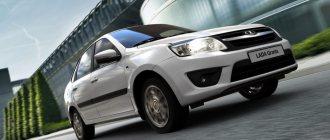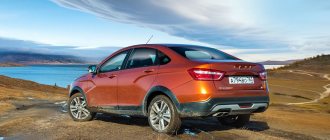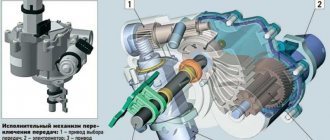In 2015, the Lada Vesta was released for the first time. Without exaggeration, it can be called a breakthrough in the domestic automobile industry. Absolutely all characteristics, both technical and design, are thought out to the smallest detail and fit together perfectly. In all respects, Vesta has surpassed its predecessors and confidently entered global markets. The designers borrowed and adapted the most interesting developments of their foreign colleagues. The price of Lada Vesta is varied and depends on many little things. Let's look at all these nuances in more detail.
General impressions of the Vesta test drive
The test drive involved two cars with different chassis - a Renault JH3 manual transmission and an AMT automatic transmission. They were tested in a variety of conditions - acceleration on a straight line, cornering, hills, hard braking and much more. Professional drivers highly appreciated not only the technical characteristics of the car, but also the ease of operation, overall interior comfort and changes in sound insulation. The test drive of the Lada Vesta provided an opportunity to see new prospects for the Russian automotive industry.
Car appearance
They worked on the appearance of the Lada Vesta for quite some time. In the final version, it acquired a more elongated shape than what is expected from domestic cars. This is not only a tribute to fashion, but also a significant improvement in the aerodynamics of the car. In particular, this was reflected in the elongated hood and sloping roof. The new Lada Vesta (station wagon and crossover) will have the same distinctive features; the designers decided to make this the highlight of the model.
Among the design features, one can highlight the letter X, which is clearly visible in the arrangement of parts on the front of the car and the sides. In the original version, X was supposed to go through the entire design solution. But they decided to abandon the reflection of the letter in smaller details for the sake of the lower cost of the car. For the same reason, they did not use LED running lights. Thus, the body of the Lada Vesta has retained its classic elegance.
With body colors, we also decided not to follow the beaten path - almost the entire spectrum is represented at the plant. You can also order some special colors. In general, Vesta’s appearance does not indicate in any way that it belongs to the Lada series in the usual sense.
Salon and interior of Lada Vesta
When entering the interior of the Lada Vesta, you immediately pay attention to the new design of the door handles - now there are no unnecessary problems, the door opens with one easy movement. The seals on the doors also took some time to figure out. It was necessary to carry out a lot of tests and eliminate a huge number of shortcomings before the seals began to provide a good level of noise insulation and tightness of the interior.
The steering column and the panel around it are primarily pleasing to the eye. Everything is so interestingly arranged that controlling the car and additional functions becomes intuitive at first glance, despite their abundance.
On the central panel of the Lada Vesta there are connectors for connecting a flash drive and a telephone.
On the steering wheel in the luxury version you can see control units for the audio system and cruise control. The light control is hidden on the left under the steering wheel, and there, but on the right, is the windshield wiper control lever. There is a vertical locking function for the wipers for easy replacement. They clear most of the windshield and provide a clear view.
The manufacturers equipped the driver's seat with the ability to adjust not only back and forth, but also in height. This is the first of the Ladas in which the seats can be adjusted in two dimensions.
Vesta's steering column is also adjustable in height and length, which allows you to completely ergonomically customize the driver's seat. Among the disadvantages: in a certain position, the steering wheel rim can cover the sensors, but this problem also exists in many foreign cars.
The interior of the Lada Vesta was not only equipped with additional functions, but also thoroughly worked on its convenience for passengers and the driver. We started with the simplest thing - expanding the interior area. We have improved the design of seats and headrests, now they anatomically correctly support the lower back and head, and prevent the development of diseases characteristic of people with a sedentary lifestyle.
The electronic control in the Lada Vesta generally works wonders - sometimes it seems that with a slight turn of the lever in this car you can control literally everything!
In particular, the driver’s life is made easier by electric heated seats and windshield, electronic control of side mirrors, built-in navigator and much more.
As a result, the comfort of the cabin pleases even on long trips - the body does not become numb, there is no need to make a lot of unnecessary movements, everything is at hand. The interior upholstery in Vesta is selected according to the client’s wishes, but only from fabric.
Technical equipment - Control and safety
The technical equipment of the Lada Vesta also includes some features designed to make the driver’s life easier. The first time the two-second pause between turning on the ignition and starting the starter is a little scary, but this is done to prevent failures at the start. The gearbox is installed in a highly adapted version, mainly due to our roads. This can be seen by the slightly extended gear shift timing. But this function provides a more comfortable transition to the new mode.
Of course, Vesta is not as smooth as foreign cars. But it holds speed well, specially designed struts are configured for medium-hard shock absorption, and the chassis makes it as close as possible to foreign versions. The car unquestioningly obeys the slightest commands.
The Lada Vesta is equipped with a special system to assist with starting on an incline. Now you don’t have to be afraid that it will stall in this case; no problems are foreseen even when reversing. By the way, for this case, the manufacturers installed side and interior mirrors of increased area.
When equipped with an automatic transmission, there is a manual mode. Even when this mode is turned on, the “robot” will change gears at the right moment if the driver forgets to do it himself. In case of bad weather, there are some tricks - rain sensors, traction control and more.
Passenger safety was taken care of very carefully. The doors are automatically locked when the driver starts the car, and the rear doors are childproof. The layout of the airbags has been thought out - each passenger has his own, and side ones can also be ordered.
During the development period of the Lada Vesta, more than 150 virtual crash tests and several dozen real ones were carried out. We checked all the nuances, carried out side and frontal collisions in all modifications, and got the expected result. In the final crash test, the Comfort version was tested, which in terms of safety indicators is practically no different from other trim levels. The test was carried out by an oblique collision with a deformable object at a speed of 65 km/h. According to the results of the crash test, the Lada Vesta received 4 stars. It outperformed many popular models in terms of safety indicators and created the first precedent for a safe domestically produced car.
At the end of the test drive, you can sum up the results. Lada Vesta has improved technical characteristics, a comfortable interior, convenient controls, a well-thought-out panel, a full range of auxiliary systems, as well as high-quality safety protection.
Lada Vesta has become more expensive than Hyundai Solaris for the first time
The average recommended retail price (RRP) for the Russian Lada Vesta (1 million 76 thousand 995 rubles) last year became higher than for the Korean Hyundai Solaris (1 million 69 thousand 91 rubles), the Russian agency reported to Gazeta.Ru. Automotive Market Research (NAPI).
Thus, the difference not in favor of the domestic bestseller amounted to almost 8 thousand rubles.
As noted in the NAPI study, in December last year it was Vesta that became the leader in terms of cost growth dynamics among the five most polar models on the Russian market. Compared to December 2022, the average RRP for this model increased by 18.1%, while its closest competitors - Hyundai Solaris and Kia Rio - over the same period, the price increased by 10.8% and 15.7%, respectively .
According to NAPI General Director Tatyana Arabadzhi, when determining the average RRP, all presented vehicle configurations were taken into account, but the price of additional equipment, which has recently been imposed by official dealers, was not taken into account. A serious jump in the average cost on Vesta (by 23 thousand rubles) occurred at the beginning of last fall, she noted.
“In September 2022, the average price of a Lada Vesta crossed the psychological mark of one million rubles. As a result, last year the RRP for this model for the first time exceeded what was indicated in the price tags of the closest competitor of the foreign brand – Hyundai Solaris,”
— Tatyana Arabadzhi noted in a conversation with Gazeta.Ru.
According to her, for a long time the cost of these cars was very close to each other, the difference was several thousand rubles. At the same time, the Korean foreign car has always been slightly more expensive than the car of a traditional domestic brand, emphasizes the general director of NAPI. However, just because of one change in the average price, Vesta did not become a more prestigious model and its positioning in the market did not change, Arabaji is sure.
“Several years ago, AvtoVAZ announced its withdrawal from the extremely cheap car segment. The company is gradually increasing the cost of its models, while simultaneously improving their equipment,” noted the general director of NAPI.
Lada Vesta has a large share of imported components, so even theoretically it cannot be much cheaper than similar models from foreign auto companies, points out independent automotive industry consultant Sergei Burgazliev. Also, the negative price trend could be influenced by AvtoVAZ’s decision to include certain additional options in the factory price. Later, this marketing ploy caused criticism from the Federal Antimonopoly Agency and AvtoVAZ was forced to abandon it.
“Thus, AvtoVAZ tried to resist dealers who charge additional equipment with a large markup. Naturally, the appearance of factory options affected the price of the car,” says Burgazliev.
Also, the price increase could be influenced by the company’s desire to take advantage of the rush demand in the car market. In the medium term, such a policy could turn against the automaker itself, the expert is sure.
According to him, buyers traditionally perceive AvtoVAZ models as more budget-friendly compared to cars of foreign brands. When they realize that Vesta is already more expensive than foreign cars, their preferences may change radically, the interlocutor is sure.
“In a situation where models of Korean brands are already catching up, and Chinese automakers have made a real breakthrough over the past year, this situation could become a very unpleasant surprise for AvtoVAZ,” Burgazliev continued.
He predicts that the updated Vesta (a restyled model is expected to appear on the market in the first half of the year) will be at least 8-10% more expensive than the current car. In this case, even taking into account the inevitable rise in price of competitors' models, it will not be easy for dealers to convince potential buyers to purchase Lada, he believes.
Lada Vesta and Hyundai Solaris are very similar in their consumer properties, which is why their prices are approximately the same, says Igor Morzharetto, partner of the analytical agency Autostat.
“Based on sales results in 2022, Vesta is leading by a significant margin from its competitors. It is quite logical that AvtoVAZ, seeing increased demand for it, increases prices,” the expert noted.
According to AEB data, in 2022 Vesta in Russia sold 114 thousand units. Sales of the Kia Rio sedan, which is close in price, amounted to 83 thousand units, Hyundai Solaris found 61 thousand car owners.
The press service of AvtoVAZ was unable to respond promptly to Gazeta.Ru’s request regarding the positioning of the Lada Vesta on the market and the increase in prices for this model. The Russian office of Hyundai refrained from commenting on the NAPI study.
Technical characteristics of Lada Vesta
When creating the engine, they took a conventional 1.6-liter sixteen-valve engine as a basis, but adapted it specifically for Vesta. They tried to change it in accordance with international environmental standards. In particular, we worked on the intake-exhaust and gear ratio. Of course, these were not the only changes.
The control program was generally developed specifically for the Lada Vesta. It provides 26 control algorithms. The rear suspension was made semi-independent torsion bar, and the front - independent. In general, in this car, almost every detail was checked and adjusted for a long time before taking its place.
Characteristics of Lada Vesta:
- The length, width and height of the body are 441 cm, 176.4 cm, 149.7 cm, respectively.
- Body type "sedan", five-seater, 4-door.
- The weight of the machine is 1 ton 230 kg.
- The full load on the car is 440 kg, the weight of the trailer is up to 900 kg.
- Engine capacity is 1.6 liters, in-line, four-cylinder.
- Brands - 11189, 21129, HR16DE-H4M
- Can be petrol or gas/petrol.
- Maximum power - 5700 rpm.
- Accelerates to one hundred km/h in 11 seconds.
- Max. The speed of the car is 178 km. at one o'clock
- Wheelbase - 264 cm.
- The remaining track width is 151 cm.
- Fuel tank - 56 l.
- Fuel consumption in the city is 9.3 liters.
- Fuel consumption outside the city is 5.5 liters.
- Average fuel consumption is 6.9 liters.
- Ground clearance is 17.8 cm.
- Trunk capacity - 480 liters.
- Wheels with a diameter of 15 inches.
New Lada Vesta
Attractive appearance of Lada Vesta
In 2014, the Volzhsky Automobile Plant surprised the public by presenting a concept car as part of the international Moscow Motor Show. The new product was liked by the public and was appreciated by both journalists and numerous auto experts. Already in 2015, full production of the four-door began. According to the generally accepted European classification, the car belongs to class B (some sources indicate B+). Its dimensions are as follows:
- Length – 4410 mm;
- Width – 1764 mm;
- Height – 1497 mm;
- Wheelbase – 2635 mm;
- Ground clearance – 178 mm.
The appearance of the flagship of the domestic market was created with the help of the famous English car designer Stephen Mattin. It is the exterior of the car that deserves special attention. Your unique style immediately attracts the eyes of passers-by. The main emphasis is placed on the design, which can be seen both in the front part and in the stampings of the side panels.
- Expressive headlight optics;
- Fog lights;
- Radiator grille with chrome inserts in the “X-design” style;
- 15-inch steel wheels with hubcaps (as standard) or 16-inch alloy wheels;
- Exterior mirrors with turn signals;
- Light factory window tinting;
- Spoiler;
- Exhaust pipe cover.
The bright, eye-catching design distinguishes the car from its main competitors. The Avignon car dealership presents the entire line of trim levels for the 2022 or 2022 release. For last year's copies, the official dealer provides additional discounts resulting from promotions carried out by the auto center.
Magnificent interior
The Vesta salon also deserves special attention. Despite belonging to the budget segment, the interior boasts a stylish design. The ergonomics of the interior decoration are also at a high level.
- Multifunction steering wheel;
- Informative dashboard with on-board computer screen;
- Acoustics – with 4 or 6 speakers;
- Audio preparation/audio system with support for FM/AM, AUX, Bluetooth, USB, SD, Hands Free, equipped with a 4.3-inch monochrome display or a 7-inch color touchscreen;
- Air conditioning/Climate control;
- Cooled glove box;
- Electric windows;
- Armrest;
- Heated seats of the first and second row (optional);
- Atmospheric lighting;
- 12V socket;
- Trunk – 480 l.
Finishing materials:
- Fabric or combination of fabric + eco-leather;
- Ecoplastic;
- Decorative elements made of metal.
“Vesta” received a thoughtful and comfortable interior, which, coupled with a low price, makes the choice of this sedan one of the main priorities of our car enthusiasts, creating increased demand for the model. Not surprisingly, sales rates are increasing quarterly.
Exceptional engine reliability and power
The Vestov engine range is represented by three gasoline, naturally aspirated, 16-valve equal-volume “engines” of both Russian and foreign production. Thus, the future owner will be able to personally select the desired configuration for his needs:
- The basic one is the VAZ-21129 with a displacement of 1.6 liters;
- Its output is 106 hp. and 148 N.m.;
- Works in tandem - with a 5-speed manual transmission;
- The intermediate level is occupied by the 1.6-liter “foreigner” HR16DR from the Renault-Nissan concern;
- Its performance is 113 horsepower and 152 Newton meters of torque;
- Transmission – continuously variable variator Jatco JF015E;
- The top one is our 1.8-liter VAZ engine;
- It generates – 123 horsepower and 173 Nm;
- Gearbox – 5-speed “mechanics”.
General indicators:
- Combined cycle consumption: 6.9-7.4 litres;
- Acceleration: 10.2-11.3 sec.
- Maximum speed: 175-186 km/h.
Chassis and braking system:
- Front suspension – McPherson;
- Rear – semi-independent, spring;
- Brakes – all disc (ventilated at the front)* *for the 106-horsepower version, rear – drum;
- The steering wheel is electrically power-assisted.
Safety:
- Reinforced body frame;
- ABS, BAS, EBD;
- Era-GLONASS;
- ISOFIX fastenings.
- In some modifications:
- AirBag – front and side (depending on the package)
- Parking sensors;
- Rear View Camera;
- Automatic door locking when starting to move;
- Rain and light sensor;
- Immobilizer;
- Stability control and brake assist systems.
Prices and options
Lada Vesta can be enjoyed in three trim levels - Classic, Comfort and Luxury.
1.6 MT Classic - price 555 thousand rubles.
The standard equipment of the Lada Vesta, meanwhile, includes many interesting things. The interior comes only with fabric upholstery, there are five headrests, the second row of seats can be solid or separate. Among the electronic equipment, it is worth noting the remote key, central locking system, automatic windows, temperature control of seats, mirrors and windshield. A total of 26 setup programs. The developers hint that the Lada Vesta Cross will be even better equipped.
The safety system is equipped with airbags for passengers, three-point seat belts, automatic door locking when driving and child protection, child seat mounts, an alarm, an immobilizer, a brake light on the rear window and the GLONASS system.
Also included are halogen headlights, special rear fog lights, an audio system with four speakers, a spare tire, and external lighting devices.
For comfortable and safe driving, there is a dynamic stabilization system, a hill assist system and an electro-hydraulic brake booster system for emergencies.
1.6 MT Comfort - price 607 thousand rubles.
In addition to the standard version, there is an extended trim for the front seats with an armrest, a ventilated glove compartment, rear parking sensors, air conditioning, radio, AUX, USB, MP3, and a hands-free device. Side mirrors and door handles match the color of the entire car.
1.6 MT Luxe — 670 thousand rubles.
In addition to the standard equipment, there are front fog lights, a light sensor, additional functions in the front seats, and a front armrest. There are power windows in the rear and airbags in the doors. For the driver's convenience, there is also a ventilated glove compartment, rear parking sensors, climate control, audio system control from the steering wheel, AUX, USB, SD card slot, MP3 support, hands free, lighting with door open sensor, rain sensor, windshield temperature maintenance , container for glasses.
You can also order additional packages from your dealer:
- Image package - price 23 thousand rubles. It includes automatic rear door windows, a spare tire, and windshield temperature control.
- Multimedia package - price 64 thousand rubles. It includes a light sensor, an audio system control unit on the steering wheel, cruise control, climate control, a multimedia system, six speakers instead of four, an SD card slot, a navigator, a monitor, a rearview camera, and lighting with a door sensor.
- Start package - price 15 thousand rubles. It includes a ventilated glove compartment and air conditioning.
- Start 6FD package - for 10 thousand rubles. less. The client receives a ventilated glove compartment and air conditioning, but there will be no rear fog lights, electric heating and electric side mirrors, as well as electric heated front seats.
- Optima package - price 9 thousand rubles. less. The client receives aluminum wheels instead of decorative caps, plus a heated windshield.
- Lime package - price 5 thousand rubles. The customer receives the car's Lime color, but without the rear fog lights.
These are the basic packages that most dealerships will offer you. There are many other original packages; availability and prices should be checked directly with dealers. By selecting additional packages, you can reduce the cost of the classic package and bring it almost to the state of the most expensive. Absolutely everything is adapted for the convenience of clients.
The main disadvantages and advantages of Lada Vesta
Exterior
The Lada Vesta sedan has a classic shape with the signature X-style of the Lada brand and characteristic side stampings.
The Russian car has good, but no alternative, halogen optics, while its competitors are equipped with LED headlights. By the way, the Vesta fog lights with cornering lights shine poorly.
The external body panels and roof of the Lada Vesta are galvanized, the anti-corrosion resistance of the body and the paintwork are of high quality, but the quality of painting of plastic parts and chrome elements leaves much to be desired - the paint peels off and chips appear.
A lot has changed since the model's existence. The color scheme has been adjusted - the dark blue “Blues” has changed to the bright blue “Diving”, “Black Pearl” to “Maestro”. Beige metallic “Carthage” has been added, orange “Mars” for Cross versions, bright green “Lime” and dark green “Krypton” have gone. The family still lacks bright enamels.
In addition, Vesta acquired a trunk opening button instead of a lock cylinder, and the large gas tank flap, designed for refueling with gasoline and methane (in the CNG version), became flat and lockable. Aerodynamic side mirrors with electric folding appeared, the usual antenna on the roof was replaced by a fin antenna.
The Lada Vesta Facelift is expected to feature narrow reflector head optics, LED lights, new front and rear bumpers, a radiator grille, as well as a different shape of the hood, wings and trunk lid. The windshield washer nozzles will completely move from the hood to the “jabot” of the car.
Interior
Lada Vesta is a B+ class car and it is not for nothing that it is famous for its spacious interior. The overall dimensions of the sedan are as follows: wheelbase 2635 mm, width 1764 mm, length 4410 mm, height 1497 mm. In the Vesta there is a lot of space in the second row both in length and width; the sedan has less headroom than in the SW. At the rear there is an armrest with cup holders, a courtesy lamp, power windows, USB connectors, a 12V socket, and heated rear sofa. The lack of niches in the rear door panels and a removable compartment in the list of rear sofas for long-length vehicles is disappointing.
Vesta's interior, with a logical arrangement of various buttons and a 7-inch touchscreen, has a front panel with modern architecture, as well as seats with a good profile, developed lateral support and lumbar support. The quality of the finishing and design of the chairs is at a decent level, they just lack the length of the cushion.
The main thing is that Vesta lags behind in the quality of plastic and interior keys. The panel looks and feels oak, the driver's window lifter unit is made roughly, the passenger window lifter button is located far away, and the climate control keys have a weak hold. By today's standards, the instrument panel and multimedia are also outdated. Today, a tidy system in the form of two wells with an on-board computer in the center or in digital format is in fashion. Touch devices on the center console have a tablet and increase in size to 10 inches.
In addition, over the years of production, Vesta has acquired a leather steering wheel, a central armrest with a box, a glove compartment lid with an organizer and a microlift, three-stage heating of the front seats, a separate button for heating the rear window, and active markings in the rear view camera. Among other pleasant little things, the model received deeper front cup holders, black headliner, door opening limiters with clear fixation, and frameless wipers.
Vesta's visibility is fine. Large glass area, large mirrors, but the A-pillars are too wide, they form a blind spot. Lada's noise insulation is one of the best in its class. This advantage was enhanced by replacing plastic fender liners with felt ones.
As for the luggage compartment of the Vesta Sedan, its volume is average - 480 liters. The workmanship is mediocre, without any hooks, nets, etc. In the spare wheel niche there is a good layer of sound insulation and an organizer. Vesta SW can offer a trunk with niches, hooks and a double floor. With the back of the rear sofa folded, the loading area is 825 liters.
I am glad that in the upcoming restyling the model will acquire original and high-quality front panel, door cards and a central floor tunnel. A feature of the interior will be a huge touch screen with Yandex.Auto services.
At the bottom of the center console there will be a large niche for a smartphone with wireless charging function. The design of the manual transmission selector will change; a button for the electronic handbrake and a selector puck for selecting the Lada Ride Select driving mode will be installed near the closed section with cup holders.
The seats should change the angle of the cushion, the armrest will become adjustable, the steering wheel will change design, a “start-stop” button will appear on the panel, two wells and a large on-board computer display will be displayed in the instrument cluster. The car will be equipped with an updated power window control unit with auto mode.
Prices/Equipment
Prices for Vesta Sedan range from 653,900 to 973,900 rubles. Kia Rio costs from 799,900 to 1,109,900 rubles, Hyundai Solaris 775,000-1,206,000 rubles, Skoda Rapid 792,000-1,171,900 rubles, Volkswagen Polo 792,900-1,209,900 rubles.
It turns out that Vesta has a competitive advantage in price of a decent 121,100-236,000 rubles. In the initial and middle versions, Vesta is better equipped, but in the “top” the car lacks much. For example, the aforementioned LED lighting technology, digital instrumentation, a modern multimedia system, front parking sensors, keyless entry and engine start systems. Fortunately, the model is equipped with front and side airbags.
Engines/Gearboxes
Photo: AvtoVAZ press service
Lada Vesta is offered with a 1.6-liter engine (106 hp) and a five-speed manual transmission, a 1.6-liter power unit (113 hp) and a continuously variable automatic transmission Jatco JF015E, a 1.8-liter engine (122 hp) and a five-speed manual transmission.
All engines are time-tested and quite reliable. The 106-horsepower engine with “stickless” pistons is frankly weak for the entire Vesta family. 122-strong “amaslozhora”. VAZ engines have a cast iron cylinder block and timing belt, Renault H4M has an aluminum block and a timing chain drive. The foreign unit operates noticeably quieter than domestic ones.
In the first year of production, the 106-horsepower Lada Vesta was equipped with a “quiet” French “mechanics”, but was soon replaced by the “howling” VAZ-21807. The 122-horsepower variant is paired with an acceptable Renault JR5 manual gearbox.
At the end of 2022, the VAZ team replaced the brooding “robot” with one clutch with a smooth variator. AMT cost 25,000 rubles and included “creeping” and “winter” modes. Today you need to pay an extra 50,000 rubles for a Jatco, but it’s comfortable in city modes. On country roads, the second delay and engine power do not allow active overtaking. A continuously variable automatic transmission requires careful operation and regular oil changes every 60,000 km or more often. The resource is about 250,000 km.
Vesta Sedan with a capacity of 106 hp. With. and 122 l. With. accelerates to 100 km/h in 11.2 seconds and 10.2 seconds, respectively, the 113-horsepower version reaches a hundred in 11.3 seconds. The average fuel consumption of the car varies - 6.9-7.4 liters per 100 km. This figure is approximately 1 liter higher than the values of analogues in the class.
We can say that the Lada Vesta lacks a classic automatic transmission with a torque converter. A faster engine is also begging for under the hood. According to preliminary data, the Vesta Facelift may feature a 1.3-liter turbo engine (150 hp) from the Renault-Nissan-Mitsubishi Alliance.
Chassis
Photo: Boris Zakharov
Lada Vesta is distinguished by good handling, a combination of an energy-intensive chassis with good smoothness. For some car enthusiasts, sharp steering settings are excessive.
It is important that the car is not adapted, but rather designed for Russian conditions. The regular Vesta has a high ground clearance of 178 mm, Cross versions have a record ground clearance of 203 mm. Vesta SW Cross and Vesta Cross are “shod” with expensive low-profile 17-inch wheels, which are sensitive to road surface defects and add rigidity.
AvtoVAZ is constantly improving the chassis of the Lada Vesta. By now, extraneous sounds in the suspension have been eliminated. The plant introduced rear disc brakes, different upper supports for the rear shock absorbers, upgraded front spring gaskets, polyurethane stabilizer bushings, a new type of stabilizer, and also installed other engine mounts, changed the intake and exhaust.
Choosing a used car
When buying a used Lada Vesta, you need to pay attention to the windshield of the car - low-quality wipers often scratch it. With frequent use in adverse weather conditions, the varnish and paint on the bumpers simply peel off. Creaks may appear in the cabin due to discrepancies in plastic parts, and the rear door trim may fly off, because young children are often seated there. It is necessary to check the fit of the seals on the door glass; if reinstalled incorrectly, they can scratch the glass, or, conversely, lag behind, causing a characteristic gap to appear.
Regarding the driving performance of the car, it is necessary first of all to carry out electronic diagnostics of the automatic transmission and control system. A manual transmission should not have problems shifting gears. Of the serial shortcomings of the Lada Vesta, only weak stabilizer links can be mentioned; they usually require replacement a little more often.
Sales of new versions of Lada Vesta
In the new Vesta, the designers decided to refine what, in their opinion, was missing in the sedan. For example, the armrest will be much wider and it will also appear between the rear seats. And the trunk will not be just a container for things; a variety of compartments have been invented in it. There are a lot of rumors around the new species of Vesta, but the developers are constantly feeding the intrigue by releasing information in small portions. It was initially planned that the first batch would roll off the production lines only in 2022, but then, quite unexpectedly, in the middle of summer they announced that the first production batch had already been released.
And at the end of the year, the Lada Vesta station wagon and crossover will be sold. The price of the new Lada Vesta will be around 600 thousand rubles, however, several trim levels are planned there. The appearance and characteristics are almost completely borrowed from the sedan; in fact, only the body shape differs.
The creators of the Lada Vesta took into account the success of their brainchild and are actively developing this direction. Many developments are still being tested and we will be able to see them in the series of subsequent years. After all, a reliable domestic car that can enter the world market is something new!
The restyled Lada Vesta FL 2022 is shown in new photos: all changes are already known
The restyled Lada Vesta FL 2022 continues to excite the minds of Russian car enthusiasts. Let us remind you that the current version of the sedan entered the domestic market in September 2015. However, the presentation of the pre-production model took place in mid-2014. A little later, a station wagon and a cross-version of the car debuted. Now it’s time to update the Lada Vesta. This past week, the restyled variation was shown online in rendered images. It is expected that the car on them will be as close as possible to the final version.
Current Lada Vesta
As you know, sales of the updated Lada Vesta 2022 should start this year. Prototypes of the restyled version of the model are increasingly found on public roads in different parts of our country. However, in all “spy” photographs, the car’s body wears dense camouflage, hiding the main changes in appearance. Not long ago, at one of the events, the manufacturer demonstrated a small fragment of video showing the new product. In particular, the video shows the graphics of the head optics. All this allowed domestic car designers to create renderings of the future market debutant (photo: kolesa.ru).
Renderings of the restyled version of the model
The first thing that catches your eye in the published images is the rather narrow head optics, in the upper part of which there are LED strips. The sides of the headlights are decorated with L-shaped inserts. The design of the front bumper has been slightly revised. The shape of the decorative inserts and horizontal slats of the air intake has changed. Another image shows the rear of the new Lada Vesta FL 2022. Here, according to the authors of the renders, the manufacturer will place updated lights. Their internal filling will also be LED. The shape of the luggage compartment lid has also changed slightly, and the area for installing the license plate has become higher. Unfortunately, the interior of the car is not shown in the renderings. However, it is already known that a large touchscreen multimedia system made in the form of a tablet and a digital “tidy” will be placed here.
As for the production process of the serial Lada Vesta 2022, preparations for it are in full swing. Thus, it became known that planned work related to the imminent production of the car is taking place not only on the Izhevsk conveyor, but also on the Togliatti one. It is reported that a local manufacturer of pedal units, one of AvtoVAZ’s suppliers, has formed the first batch of units, consisting of 100 units. All of them are installed on models with a CVT transmission. The manufacturer is also completing the setup of the pipeline to eliminate possible failures during full serial production. Sources close to AvtoVAZ report that adjustments to the line were made in Izhevsk. This eliminates the risk of the vehicle body tipping over while passing through the chassis line. In addition, engineers have finalized the process of installing the engine under the hood of the updated model. Now the possibility of its displacement during installation is completely excluded.
It is worth recalling that earlier during the pre-production assembly of the restyled Vesta, a serious defect was identified. Moreover, half of the prototypes had a malfunction. We are talking about the failure of the digital dashboard. Note that this equipment will appear for the first time in the list of available products for the domestic model. A defect in the shield, in turn, leads to a breakdown of the entire electrical system of the vehicle. As a result, the car refuses to move. It is expected that updating the conveyor will allow the Russian developer to eliminate the identified breakdown as soon as possible. Let us remind you that the serial assembly of the new Vesta should start in early spring of this year. The model will arrive at dealers in May – June.











